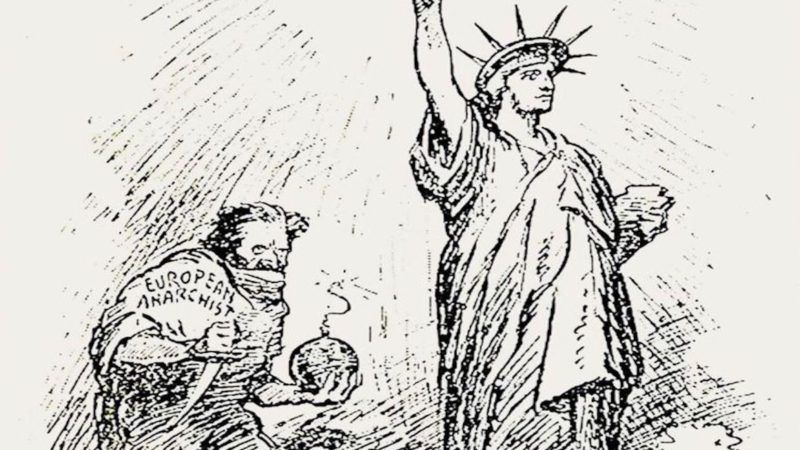The Long Shadow of the Palmer Raids
A century ago, the Wilson administration cracked down on immigrant anarchists. The raids lasted three months, and their impact was felt for decades.

The last of the Palmer raids happened a century ago, at the end of January 1920. Launched the previous November by Attorney General A. Mitchell Palmer, the raids had been a sweeping crackdown: Police had arrested thousands of immigrants across the country, most of them originally from Italy or Eastern Europe. Many of the arrests were carried out without warrants, and many of the arrestees were guilty of nothing more than being foreign-born; the majority were eventually released without charge. But hundreds still found themselves on ships to their countries of origin, even after decades of living in the United States.
The raids were a response to a wave of anarchist mail bombings in the summer of 1919, a spree that had sent shock waves through the country. (The number of injuries was small, but this was due more to the bombers' incompetence than to anything else.) Labor unrest had spread in 1919 too, and many Americans blamed foreign conspirators for the trouble. Much of the country was open to repressive responses. One city—Gary, Indiana—dealt with a chaotic strike by declaring martial law.
For the White House, this was also an opportunity to show the back of its hand to a group it didn't much like anyway. President Woodrow Wilson had already signaled his distrust of "hyphenated Americans," and his administration was skeptical about immigration in general. The First World War had proven useful in this respect: It enabled measures against "enemy aliens," which proved to be a more flexible phrase than simply targeting supporters of the Kaiser. It also permitted the passage of the 1918 Immigration Act, which aimed to "exclude and expel from the United States aliens who are members of the anarchistic and similar classes."
The two most famous anarchists deported in the wake of the Palmer raids were Emma Goldman and Alexander Berkman. They were already in prison before the raids, so their cards were marked. But when they left in December on the Buford—a ship nicknamed "the Soviet Ark," since it was carrying its human cargo to the nascent Soviet Union—they were joined by dozens of others nabbed in the raids, scooped up and shipped out as perceived threats. The was some irony in taking people who had emigrated from Czarist Russia and deporting them to the new Bolshevik state, which was not the country they had left. (Goldman quickly realized that the revolution did not live up to her anarchist ideals, and she described the authoritarian atmosphere there in her 1923 book My Disillusionment in Russia.)
Unlike Goldman and Berkman, most of those deported weren't famous; they were just working-class immigrants with leftist politics. This helped maintain the idea that anarchists were shadowy foreigners and strangers to the American society. Anarchism was thus cast as both anti-American and un-American, a scourge that could be driven away and pushed back abroad. The immigration laws were tightened to reduce arrivals from Southern and Eastern Europe, regarded as the main sources of anarchist influence.
Initially, public support for the raids was strong. A New York Times editorial in December 1919 reflected the views of many: "There are ten or eleven millions of aliens here. Why give any questionable new arrival the benefit of the doubt? Why not give the country that benefit? Why let loose aliens who are to be deported? The humane sympathies of the immigration authorities do them honor, no doubt, but sometimes lead them into strange tenderness towards undesirables and even anarchists."
But the mood shifted after the raids. Predicted future violence did not occur, and the threat seemed to have passed, as anarchist bombings largely disappeared from the American political scene. (Giuseppe Zangara's attempt to assassinate President Franklin Roosevelt was a last remnant, in 1933.) Some Americans saw this as evidence that the raids had worked, but for others it was evidence that Palmer had overreached. The public appetite for mass roundups faded, and the post–World War I red scare was over.
Yet its influence lingered. What historians and sociologists call the "great pause" of immigration had begun, and it didn't end until a change in immigration law in 1965. The scare had a still longer demographic tail, as the last of the pre-1920 immigrant generation died out: The percentage of foreign-born people living in the U.S. was lowest in 1973.
For the authorities, anarchists had served their purpose as bogeymen for general social unrest. Some anarchists were dangerous, of course, but "anarchists," writ large, had become a focus for a more broad-based social fear. They were a leaderless group to whom anyone could claim affiliation, and which could not disclaim any purported members. That made them a perfect villain. And the blame that fell on them extended easily to entire populations of immigrants.
